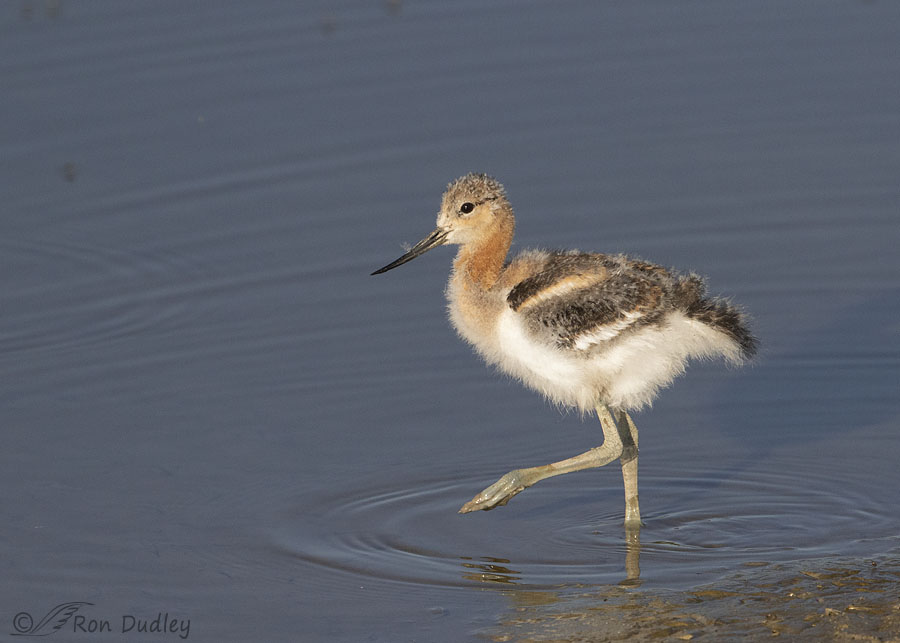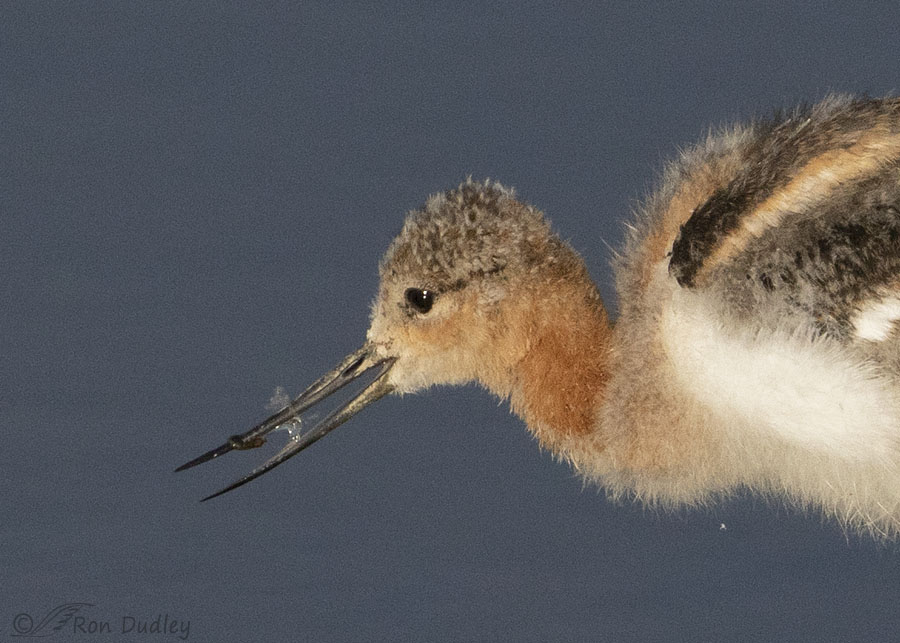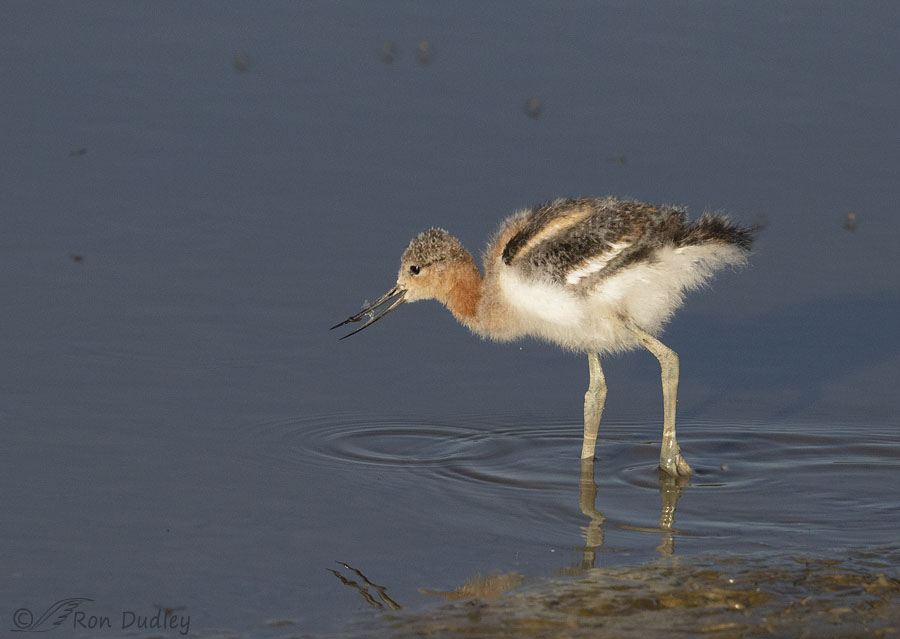At this age avocet chicks are fluffy-butt cuties.

1/5000. f/6.3, ISO 800, Canon 7D Mark II, Canon EF 500mm f/4L IS II USM + EF 1.4 III Extender, not baited, set up or called in
Three days ago I spent some time with several Black-necked Stilt and American Avocet chicks at Bear River MBR. I caught this young avocet as it briefly paused in its feeding activities to check out its surroundings. I quite like this shot because of the raised-leg pose, good light on the entire bird, eye contact and the bit of fluffy down stuck to its bill.
The color of the mostly natal down plumage of avocet chicks at this age already closely matches that of the adult in breeding plumage which some authorities believe to be a form of adult auto-mimicry, intended to fool predators into thinking they’re adults or nearly so and already capable of flight.
1/8000. f/6.3, ISO 800, Canon 7D Mark II, Canon EF 500mm f/4L IS II USM + EF 1.4 III Extender, not baited, set up or called in
Being a precocial species avocet chicks stay in the nest no more than 24 hours after hatching of the last chick in the brood and begin to feed themselves almost immediately. This youngster was already skilled at finding food and likely had been for some time.
Here it has captured a tiny invertebrate but that pesky piece of down is still stuck to its bill.

A huge crop of the previous photo (5% of the original image) gives us a better look at the food morsel, probably a larval insect.
On this day at the refuge stilt and avocet chick size varied considerably but overall their breeding season is coming to a quick conclusion. I hope to get out there again before it’s completely over but it’s going to be close.
Ron



Yes, where do all these roadblocks come from?
I’d like a sassy Avocet chick to give the a leggy boot!
Wonderful shots Ron, and told so well.
Aww, too cute. Thanks!
You’re very welcome, Jean.
D’awwww. Cute little flufferbutt. He looks so proud prancing around in the first shot. Thanks for the adult automimicry lesson, Teech! 🙂 Fascinating!
Thanks, Marty. Prancing is a good word to describe the little feller in that shot.
Indeed, cuteness personified (or should that be birdified?)
Adult auto-mimicry. A new one for me. I googled it and, lo and behold, research on this was done at Bear River MBR by one Tex A. Sordahl : “The American Avocet (Recurvirostra americana) as a
paradigm for adult automimicry”.
Lots of good research has been done at Bear River MBR over the years, Lyle – yet another reason I dislike seeing it threatened by water issues etc.
A really great series of an adorable chick! The harder I try to make it to the wetlands to look for young birds the more life throws up road blocks!
It ain’t fair, waaahhhh.
Thank you, Ron, for the continuing morsels of inspiration.
I understand that roadblocks thing. And the older I get the more of them that appear. Thanks, Wally.
A big awww from here.
Cute and able to feed itself from an early age? I suspect that many a human parent has twinges of envy.
Probably all of them EC. And there’s no diapers to change either.
Ron,
Nice detail and info, as usual. Great shots.
Stephen
Thank you, Stephen.
Wonderful as always!
I was hoping to get up that way today but I am stuck making sure releases go well. Which today went very smoothly. No breezes, conflicts or opportunistic Cooper’s hawk.
April, that must really hurt when a predator gangs up on one of your releases after you guys have invested so much time, effort, money and love in them while you’re nursing them back to health.
Your posts are so enjoyable! Thank you.
Thanks very much for saying so, Richard.
I’ll SAY “fluffy-butt”– the texture you’ve captured in the blowup of the shot makes me want to reach out and stroke my computer screen……….
I’ve heard about you people who stroke your own computer screens… 🙂
AWWW! 🙂 They certainly are cute at that age even if a bit messy and with those, mostly, adult legs.:) They look SO much stouter than when they “grow into them” 😉
“They look SO much stouter than when they “grow into them””
They sure do, Judy. Looks like they could kick the crap out of their spindly-legged parents… 🙂
Adorable young Avocet. Very nice series Ron. Envious once again. Have never seen one here. Like most of nature’s young they are required to very quickly grow up and be ready to fly or run or swim. There is always a predator somewhere close by.
Thanks, Everett. One thing that impresses me about this youngster is how stout its feet and legs are.
Wonderful series Ron!
Charlotte
Thanks, Charlotte.